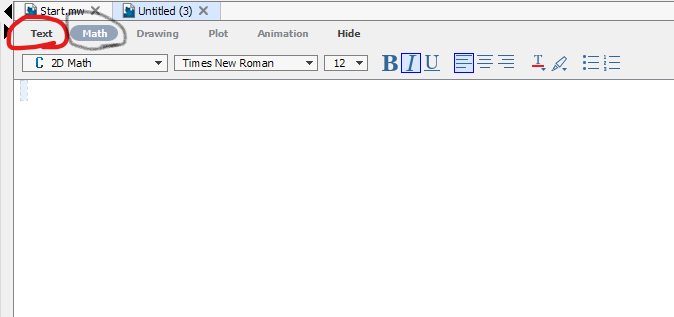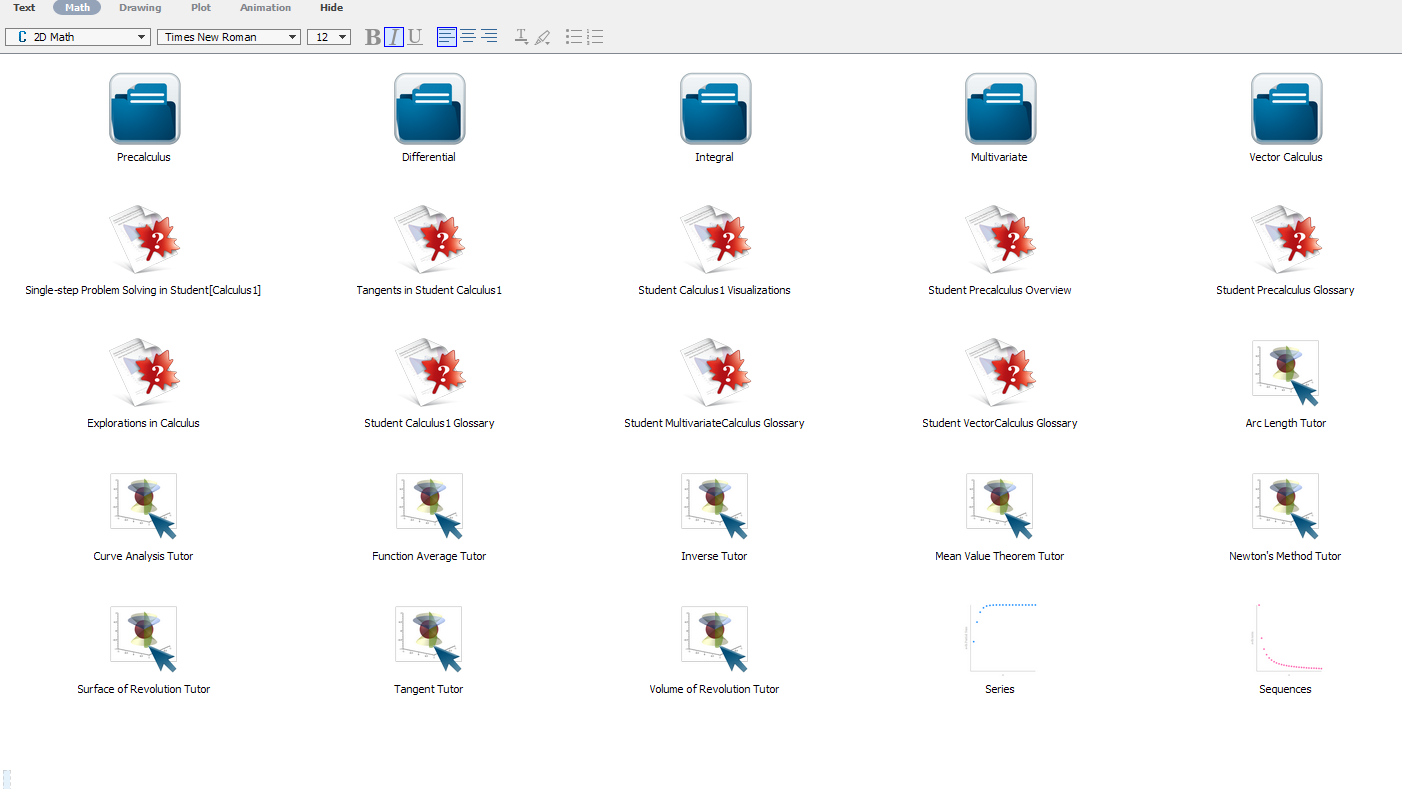Topic 1 Basics in Maple
1.1 What should I do after I opened Maple
Once you opened Maple, you will see the following Maple Start document.

Maple start page screenshot
- If you already know what you want to do, then you may open a new document by clicking
New Documenticon in the start document. The following shows what an new (empty document) looks like.

Maple new document page screenshot
In this new document you may type in text under Text mode or evaluate a Maple syntax in the Math mode. (See the following picture).

Maple text and Math modes screen shot
If you want to explore some featured sample documents, you may go to
Start.mwdocument and click on different icons to open a new document.- You may alway reopen the start page by click the home icon to reopen the start page.

Maple reopen start page screenshot
For Calculus, the most useful document is
Calculus.

Maple start page screen shot with Calculus highlighted
If you click the Calculus icon on the Start page and click OK, you will see the following document.

Maple Calculus document page screen shot
1.2 Basic Operators
The first thing to know when learn something new is where and how to get help. In Maple, you may simply type
?keyword
to open a help page (a new window).
For example, the command ?operators will lead you to descriptions of arithmetic operators in Maple.
| addition | subtraction | multiplication | division | exponentiation | |
|---|---|---|---|---|---|
| Maple Operators | + |
- |
* |
/ |
^ |
| In writing | |||||
| In Maple | x+2 |
a-b |
2*x |
p/q |
b^5 |
1.3 How to define a function
A function is an assignment, for a given input , we assignment an output under a certain rule. Maple take this idea to define functions. The command to define a function has the following form.
function name:= independent variable -> function rule
Here := means “defined/assigned to be” and -> may be understood as “plug in”.
Example 1.1 Define the following function in Maple and find the value .
Solution. The function name is , the independent variable is and the function rule is . So the function can be defined in Maple by the following command.
f:=x->x/(x-1)Once the function is define, you may find the function value by the command f(0.999).
Remark.
The assignment operator := to the left-hand side the value of the right-hand side. The left-hand side normally is a name and the right-hand side is a value or expression.
Exercise 1.1 Define the following function in Maple and find the value .
1.4 Initially known mathematical functions
Maple has many predefined functions which can be used to create new functions. To see all initially known mathematical functions in maple, you may use the help command ?functions and click the hyperlinked “initial functions” in the description shown in the new window.
Maple function help page screenshot
Some frequently used functions are listed in tables below.
| absolute value | square root | n-th root | natural exponential | logarithmic |
|---|---|---|---|---|
abs() |
sqrt() |
surd(,n) |
exp() |
log(),log[b](), ln() |
| sine | cosine | tangent | cotangent | secant | cosecant |
|---|---|---|---|---|---|
sin() |
cos() |
tan() |
cot() |
sec() |
csc() |
| inverse sine | inverse cosine | inverse tangent | inverse cotangent | inverse secant | inverse cosecant |
|---|---|---|---|---|---|
arcsin() |
arccos() |
arctan() |
arccot() |
arcsec() |
arccsc() |
Another initially know function that we will use is the piecewise function.
piecewise(condition1, expression1, condition2, expression2, expression3)
Example 1.2 Define the following function in Maple and evaluate
Solution. The function can be defined by the following command.
pwf:=x->piecewise(x<-1, sqrt(sin(x)), x>=-1 and x<Pi,
surd(x, 3)/abs(x+2), ln(exp(x)+2))The value can be obtained by the command pwf(3).
Exercise 1.2 Define the following function in Maple and evaluate
1.5 Plot functions
In Maple, you may plot a single variable function easily using the command
plot(expression, domain, options)
or plot several single variable functions together using
plot([experssion1, experssion2], domain, options)
In the command, options may be omitted, but the domain must be given.
To see details about available options, you may run the command ?plot in Maple.
Example 1.3 Plot the functions in red and in blue over the domain .
Solution. Here are the command and the output
plot([x^2, 2*x+1], x=-1..2, color=[red, blue])Screen shot of the output generated by plotting of two function
Exercise 1.3 Plot the piecewise function in Exercise 1.2 over the domain .
Exercise 1.4 Plot the functions and over the domain .